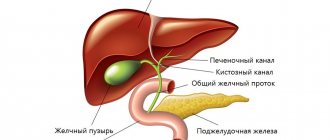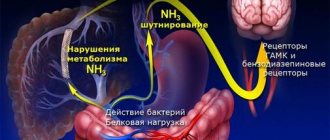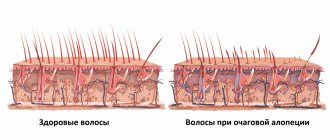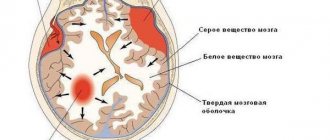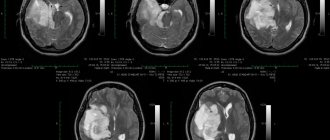Find out more about other pathologies starting with the letter “D”: Debility, Double-wave viral meningoencephalitis, Dementia with Lewy bodies, Depressive neurosis, Dermal sinus, Cerebral palsy, Jacksonian epilepsy, Diastematomyelia (diplomyelia), Discogenic myelopathy, Dystrophic myotonia Rossolimo-Steinert-Kurshman , Diabetic encephalopathy, Dyscirculatory encephalopathy, Diffuse axonal damage to the brain, Benign rolandic epilepsy.
Discirculatory encephalopathy: the danger of pathology and treatment methods
This pathology is a brain lesion that occurs due to constant progressive circulatory disorders of the central nervous system of various etiologies. It affects motor, emotional and cognitive function, and depending on the severity of the symptomatic picture is divided into three stages. To make and confirm the diagnosis, ultrasound, echo-EG, EEG, REG, duplex scanning of cerebral vessels, ophthalmoscopy, MRI are required. Therapy is selected individually and consists of neuroprotective, antiplatelet, antihypertensive, vascular and other drugs.
Causes
The main reason for its appearance is chronic cerebral ischemia caused by various vascular disorders:
- About 60% of cases of DEP are caused by atherosclerotic changes in the walls of cerebral vessels;
- Arterial hypertension ranks second in the list of causes. It can be observed in a number of pathologies: chronic glomerulonephritis, hypertension, polycystic kidney disease, Itsenko-Cushing's disease, pheochromocytoma, etc.
- Hypertension provokes encephalopathy due to the occurrence of vasospasm of the central nervous system, leading to depletion of blood flow;
- Pathology of the vertebral arteries can also cause the disease, as it is responsible for 30% of cerebral circulation. If the primary disease is instability of the cervical spine of a dysplastic nature, osteochondrosis, Kimerli's anomaly, developmental defects or previous spinal trauma, a symptomatic picture of circulatory disorders in the vertebrobasilar region is observed;
- DEP often occurs as a concomitant disease with diabetic microangiopathy. If, with diabetes, the patient is unable to adjust the blood glucose level to the upper limits of normal.
Also, the causes of dyscirculatory encephalopathy can be:
- Chronic or persistent hypotension;
- Arrhythmia;
- Hereditary angiopathy;
- Traumatic brain injuries;
- Systemic vasculitis.
Prevention
Encephalopathy is a complex disease. There is no clear method to prevent its occurrence and eliminate all risk factors. Doctors recommend adhering to the following rules:
- provide yourself with a full daily routine with alternating work and rest, a full night’s sleep;
- minimize stress;
- eat properly and balanced, avoid overeating and excess body weight;
- ensure sufficient supply of vitamins and microelements;
- quit smoking, drugs, alcohol;
- exercise in moderation (not professionally);
- promptly identify and treat chronic diseases: hypertension, diabetes, atherosclerosis;
- consult a doctor at the first signs of trouble.
The mechanism of pathology development
The pathogenesis of dyscirculatory encephalopathy includes factors leading to deterioration of cerebral circulation, consequently to hypoxia and disruption of trophism of cells of the central nervous system. This leads to cell death and the appearance of areas of rarefaction of brain tissue, that is, leukoaraiosis or silent infarctions - multiple small lesions.
The subcortical structures and white matter of the deep parts of the brain are most susceptible to destruction during DEP. This is due to their location on the border of the carotid and vertebrobasilar basins. Chronic ischemia provokes the phenomenon of disconnection, that is, disruption of connections between the cerebral cortex and subcortical ganglia. Experts believe that this is the main pathogenetic mechanism. It causes a characteristic symptomatic picture:
- Violation of the emotional sphere;
- Cognitive disorders;
- Pathologies of motor functions.
A distinctive feature of DEP is the reversibility of functional disorders at the first stage of the disease with appropriate treatment and the persistent nature of neurological defects leading to disability at later stages.
Treatment at the Energy of Health clinic
Doctors at the Health Energy Clinic are always ready to see patients of any age. We will conduct a thorough examination, identify possible causes of encephalopathy and take all measures to eliminate it:
- we will prescribe the most appropriate therapy, describe the course of treatment and the frequency of its repetition;
- We will carry out all the necessary manipulations (placement of a drip, intravenous and intramuscular injections) in the comfortable conditions of a day hospital and manipulation room;
- We will complement the therapy with modern physiotherapeutic procedures;
- We will conduct a massage course and prescribe exercise therapy for maximum effectiveness.
Our neurologists will monitor the patient’s condition and adjust treatment if necessary. Treatment of encephalopathy is a long and complex process, but we are ready to take on it.
Classification of dyscirculatory encephalopathy
DEP is distinguished by etiology:
- Atherosclerotic;
- Hypertensive;
- Venous;
- Mixed.
According to the speed of development, it can be rapidly progressing or galloping and slowly developing, that is, the classic form.
The severity classification is as follows:
- The first stage is accompanied by subjective feelings of ill-being, mild cognitive impairment, and preservation of the neurological status;
- The second stage is characterized by obvious motor and cognitive disorders and increased emotional distress.
- The third stage is considered the most severe, at which mental disorders begin. It represents vascular dementia of varying severity.
Early symptoms
DEP begins unnoticeably and develops quite slowly. First of all, problems in the emotional sphere are noted. About 65% of patients suffer from depression, which, unlike depressive neurosis, occurs against the background of minor traumatic situations, while patients are not inclined to note depression and low mood. They are fixed on various somatic disorders, like patients with hypochondriacal neurosis. Complaints may include:
- Arthralgia;
- Back pain;
- Neuralgia;
- Noise in the head;
- Tinnitus;
- Pain of various localizations.
Their distinctive feature is that they do not fit into the clinical picture of supposed somatic pathologies. Depression in DEP is difficult to respond to psychocorrection and treatment with antidepressants.
The initial stage of DEP often manifests itself in increased emotional lability, which includes:
- Sudden mood swings;
- Cases of uncontrollable crying for minor reasons;
- Irritability;
- Attacks of aggressive behavior towards others.
In addition, sleep disturbances, fatigue, headaches, and absent-mindedness are noted. The symptomatic picture is similar to neurasthenia, but with dyscirculatory encephalopathy the symptoms are combined with cognitive impairment.
Moreover, in 90% of patients, cognitive impairment occurs at the initial stage of the disease. These include:
- Decreased concentration;
- Memory impairment;
- Reduced speed of thinking;
- Difficulties in planning activities;
- Fatigue with mental effort;
- Problems with speech reproduction of information while maintaining memory.
Movement disturbances, such as dizziness and unsteadiness when walking, may also occur. DEP must be differentiated from vestibular ataxia, since nausea and vomiting may be present, but only during walking.
Make an appointment with a neurologist
Clinic No. 1 in Moscow offers a competent consultation with a neurologist. The multidisciplinary medical center is located in close proximity to the Lyublino metro station. The clinic has all the modern technical capabilities for successful diagnosis and treatment of many diseases. You can make an appointment by phone or through our website.
Moscow, st. Krasnodarskaya, house. 52, bldg. 2
+7
We work on weekdays and weekends from 8.00 to 21.00
Clinical picture at stage II-III
In subsequent stages, the clinical picture grows and intensifies: memory deteriorates significantly, attentiveness and intelligence decrease, and difficulties are noted when performing habitual mental work. Patients are unable to adequately assess their own condition and tend to overestimate their performance and intelligence. Over time, the ability to develop a program of action, generalization, and orientation in time and space is lost. At the third stage, disturbances in praxis and thinking are noticeable. Personality and behavior disorder occurs. Dementia is noted, in which patients lose the ability to work, and in more severe cases, self-care skills.
The emotional stage is dominated by apathy, loss of interest in previous hobbies, and lack of motivation. At the third stage, patients do nothing or are engaged in unproductive activities. They are indifferent to themselves and their surroundings.
If at the first stage motor disorders are weakly expressed, then at later stages these disorders are visible to others. Typical manifestations are:
- Slow gait in small steps;
- Shuffling;
- Falls when walking or turning, which are often accompanied by fractures, especially if the patient suffers from osteoporosis;
- Difficulty starting or stopping in time.
Clinical manifestations, especially the characteristic “skier’s gait,” are similar to the symptoms of Parkinson’s disease, but are not accompanied by abnormalities in the arms, so experts call such signs of DEP “vascular parkinsonism” or “lower body parkinsonism.” Also, the last stage is accompanied by:
- Urinary incontinence;
- Pseudobulbar syndrome;
- Paresis;
- Tremor;
- Severe aphasia;
- Symptoms of oral automatism.
Epileptic seizures may occur.
Methods for diagnosing DEP
It is very important to make a diagnosis as early as possible in order to promptly begin vascular therapy to compensate for neurological disorders. Therefore, all patients at risk for discirculatory encephalopathy must be regularly examined by a neurologist. The risk group includes:
- People suffering from atherosclerosis;
- Diabetics;
- Hypertensive patients;
- Aged people.
To identify cognitive impairment, special tests are required. Tasks may include the need to remember and repeat a list of words named by the doctor, draw a dial with a given time, or repeat certain words.
In addition, consultation with an ophthalmologist and ophthalmoscopy, determination of visual fields, will be required. The following hardware diagnostic methods are shown:
- Echo-EG;
- EEG;
- REG;
- ECG and daily ECG monitoring;
- Doppler ultrasound of head and neck vessels;
- MRA of cerebral vessels;
- Duplex scanning;
- MRI of the brain.
MRI of the brain will help distinguish DEP from other pathologies: Alzheimer's disease, Creutzfeldt-Jakob disease, disseminated encephalomyelitis. Magnetic resonance imaging makes it possible to visualize foci of silent infarctions, while areas of leukoaraiosis and cerebral atrophy also occur in other neurodegenerative pathologies.
To detect etiological factors, consultation with a cardiologist and nephrologist, blood pressure monitoring, a coagulogram, determination of lipoproteins and cholesterol in the blood, and a blood sugar test are required.
FAQ
Which doctor should I contact?
Discirculatory encephalopathy is a neurological disorder. If alarming symptoms occur, you should contact a neurologist. The doctor will order an examination and make an accurate diagnosis, based on the results of which he will prescribe adequate treatment. The sooner treatment measures are taken, the more optimistic the prognosis for the patient will be.
How long can you live with dyscirculatory encephalopathy?
Life expectancy depends on genetics, concomitant diseases, the severity of atherosclerosis or hypertension. Therefore, it is completely different for different patients.
Therapy
The therapeutic approach to the treatment of encephalopathy should have an etiopathogenetic direction and be comprehensive. It is necessary to compensate for the primary disease, enhance microcirculation and cerebral circulation, and also protect the cells of the central nervous system from ischemia and hypoxia.
Etiotropic treatment of DEP includes the selection of hypoglycemic and antihypertensive drugs, which should be prescribed individually. An anti-sclerotic diet is also indicated. If cholesterol levels do not decrease even with dietary correction, appropriate medications are prescribed, such as gemfibrozil, lovastatin, probucol.
The basis of pathogenetic therapy is drugs that improve cerebral hemodynamics. It is important that they do not lead to the effect of stealing. These are calcium channel blockers such as flunarizine, nifedipine, nimodipine, as well as α2-adrenergic receptor antagonists, such as nicergoline or pyrobedil, and phosphodiesterase inhibitors: ginkgo biloba, pentoxifylline. Since DEP is often accompanied by increased platelet production, the patient needs lifelong use of antiplatelet agents, which include ticlopidine or acetylsalicylic acid. If the patient has contraindications, such as gastrointestinal bleeding or stomach ulcers, dipyridamole may be prescribed.
It is very important to take drugs with a neuroprotective effect, which allow neurons to function under conditions of chronic hypoxia. These include:
- Piracetam;
- GABA derivatives: gamma-aminobutyric acid, aminophenylbutyric acid, N-nicotinoyl-gamma-aminobutyric acid;
- Membrane stabilizing drugs: choline alfoscerate;
- Cofactors;
- Medicines of animal origin: porcine cerebral hydrolysate, hemodialysate from the blood of dairy calves, cortexin;
- Vitamin and mineral complexes.
If discirculatory encephalopathy is caused by a narrowing of the lumen of the internal carotid artery reaching seventy percent, it usually progresses very quickly and is accompanied by small strokes or episodes of PNMK. In such a situation, surgical intervention is indicated. It could be:
- Carotid endarterectomy for stenosis;
- Extra-intracranial anastomosis with complete occlusion;
- Reconstruction of the vertebral artery in case of damage.
Doctor's forecasts
With effective and timely therapy, the development of DEP at the first or second stage in most cases slows down. Occasionally, rapid development of the disease is observed, in which case each stage takes about two years. When dyscirculatory encephalopathy is combined with degenerative changes in the central nervous system, the prognosis is most often unfavorable. Hypertensive crises, ischemic or hemorrhagic strokes, TIA and other cerebrovascular accidents, and uncontrolled hypoglycemia that accompany the disease have a negative impact on the recovery process.
Advantages of the clinic
If you require a full examination and high-quality treatment, welcome to the Health Energy clinic. Here you are waiting:
- experienced specialists who regularly improve their skills to keep abreast of all new trends in the world of medicine;
- modern diagnostic equipment;
- everything necessary for physiotherapy, massage, exercise therapy;
- own day hospital for slow drip administration of medications;
- affordable prices for all services.
If you or your relatives have signs of encephalopathy, do not delay contacting a doctor. The sooner treatment is started, the better the result. Sign up for the Health Energy clinic and let our doctors choose the optimal therapy.
